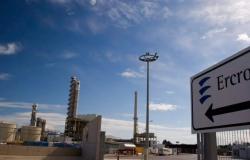The Government made it explicit that it will maintain the official exchange rate as an inflationary anchor, always with the objective of unifying the dollar market in the near future.
The gradual increase of 2% monthly puts the reduction of inflation as a priority, although it incubates an incipient backwardness of the dollar and a rise in the gap that, at the same time, stretches the deadlines to eliminate the “traps.”
Furthermore, analysts predict that, after the period of greatest export liquidation due to the soybean and corn harvest, it will be difficult for the Central Bank to purchase foreign currency, another reason that is justifying the maintenance of exchange controls, to influence the price and quantities of available currencies.
While the growth of reserves stagnates, the Government insists on keeping the devaluation controlled to favor the process of falling inflation
On the other hand, the pesos are still surplus, although they are not noticed because they are placed at interest rates in fixed terms, common investment funds and short-term Treasury bonds. The process of reducing remunerated liabilities of the BCRA stands out, which results in a record growth of public debt, which implies that the pesos already issued are still present as a heavy counterpart to the stock of dollars registered in the system.
“Although the control over monetary emission of fiscal origin is strict, there is expansion via the banking multiplier,” he observed. Jorge VasconcelosChief Economist of the Ieral of the Mediterranean Foundation, while he considered that “in May credit increased almost 10%, double inflation, a phenomenon associated with the decrease in the interest rate.”
Although today there are many pesos stored in bank current accounts – a condition that reduces the “systemic risk” – it still draws attention that the Monetary Base ($17.2 billion) has grown 70% since he took office. Javier Milei, while monetary circulation – the main component of the Base and a factor of pressure on prices and the dollar – increased 62% in just over six months, to $10.7 trillion. In the same period, the price of the official dollar rose 147.7%, from $364.41 (BCRA Communication A3500) to $902.50 per unit.
In the same period, inflation accumulated 115%, double the rate of increase in the money with which the economy is managed, but below the devaluation jump, evidence that both variables – amount of pesos and exchange rate – are decisive in determining inflation, today at an intermediate level between both.
Therefore, in this transition carried out by the La Libertad administration, it advances towards the objective of lowering inflation to a reasonable threshold, stabilizing the dollar at a balance level and eliminating exchange controls on the inflationary level, there is a determining factor, which is the income of dollars to the economy to compensate for that enormous mass of excess pesos that justifies an exchange gap still close to 40 percent.
This expected injection of foreign currency did not occur in the required magnitude. Even with accumulated purchases by the BCRA in the market of around USD 18,000 million since December 11, the increase in gross stock increased by just over USD 8,000 million.
And in the last two months, when a growing contribution of agricultural currencies was expected, the reserves stopped growing, with a ceiling of USD 30,000 million. In this regard, public debt commitments are a burden for a recovery in the stock of foreign assets, before a second semester that could leave the BCRA on the selling side of the counter until the wheat liquidation in the summer.
When a growing contribution of agricultural currencies was expected, the reserves stopped growing, with a ceiling of USD 30,000 million
“Despite the variation in the export dollar, net foreign currency purchases by the Central Bank went from an average of USD 155 million per day in the first half of May to less than USD 20 million at the start of June. This is during the most abundant time of year for agrodollars. Currency table, falling international prices and persistence of high withholdings combine to sink the purchasing power of soybeans in the domestic market, 20% below the 25-year average. The volume of the harvest improved substantially, but the preference for savings – silobolsas – of the farmers is predominating,” Vasconcelos stated.
José María Segura, Chief Economist of PwC Argentina, highlighted that “the downward trend in the price of financial dollars was reversed. If we add to this that we are approaching the end of the second quarter, where the seasonality of exports decreases, and the BCRA could stop accumulating reserves through the commercial channel, and the inflation rate, which, although downward, is still far away. From the monthly devaluation rate, it can be inferred that market expectations regarding the capacity of the monetary entity to sustain the current rate of devaluation crawling They could be changing.”
“The drop in FOREX traded volumes in MAE is striking in a month where seasonality should favor agricultural settlements, even more so if the recovery of production in the 2023/24 Campaign is considered. According to analysts, the latter could be for logistical reasons – delays in the advance of the thick harvest – together with expectations of better prices in the near future, or perhaps, a more competitive exchange rate for the sector. However, it is important to consider that staggered access to the Free Exchange Market for most importers, the lack of authorization for payment of imports of finished automobiles and other tariff positions, as well as the recession, continue to favor the purchase of foreign currency. by the BCRA”, considered from TSA Bursátil.
The drop in FOREX traded volumes in MAE is striking in a month where seasonality should favor agricultural liquidations, even more so if the recovery of production in the 2023/24 Campaign (TSA Stock Market) is considered.
In the last week, the Minister of Economy Luis Caputo came to the crossroads about versions of a new devaluation of the peso, after the magnitude exchange rate jump that was applied on December 13 and that took the official exchange rate to 800 pesos.
“Given the unfounded rumors, we clarify with Santiago Bausilithat if the Bases Law is approved, the reduction of the PAIS Tax It is not associated with any devaluation. The current 80/20 (agricultural liquidation scheme) or the 2% (monthly) crawling will not be touched either,” the official expressed through his account on the “X” social network.
However, this decision to “step on” the dollar to “anchor” inflation, to which previous governments already appealed, has a cost in the rapid loss of exchange competitiveness, as exposed by the Multilateral Real Exchange Rate Index that the BCRA itself and which today stands at 89 points, eleven below the theoretical equilibrium level of 100 and increasingly closer to the 80 points bequeathed by Sergio Massa after passing through the Ministry of Economy during the previous government.
It must be remembered that this indicator touched 162 points on December 13, 2023, immediately after the devaluation and since then it has reduced 45%, about 73 points, which is basically the gap between the inflation rate and the devaluation rate of the last six months.
“If you step back from the situation and look at the entire movie, if things are done well there is an energy industry, which could generate a huge influx of dollars. And that lack of dollars that always affects us should be resolved. It seems that Argentine society understood that the fiscal deficit is a problem and led us to inflation for the last 100 years. And that is why he is digesting with such importance the mega adjustment that occurred, as a key step to right a ship that was going in the wrong direction,” he commented. Cristian LopezPartner and Director of Novus Asset Management, the Managing Company of the PPI Group (Personal Investment Portfolio).
By “stepping on” the exchange rate, the Government assumes the cost of a higher gap and the loss of competitiveness, which distances the exit from the “traps”
José María Segura stressed that “a condition of balance for stocks is necessary. It is known that, if an economic agent wants to set the market price, he must be able to empty it, that is, offer the quantity demanded at said price. In that sense, unless a free floating policy is proposed – an alternative that we understand is ruled out -, the liabilities of the BCRA should maintain a reasonable relationship with the assets – in a more restrictive way, with the reserves -, since this relationship is which will give sustainability – or not – to the exchange rate – if it is fixed – or the exchange rate rule – if it is a managed float – that is set. That is, it is from this relationship that expectations will be generated regarding whether or not the BCRA has the capacity to sustain the exchange rate in the face of an initial drop – upon exit from the stocks – in the demand for money.






